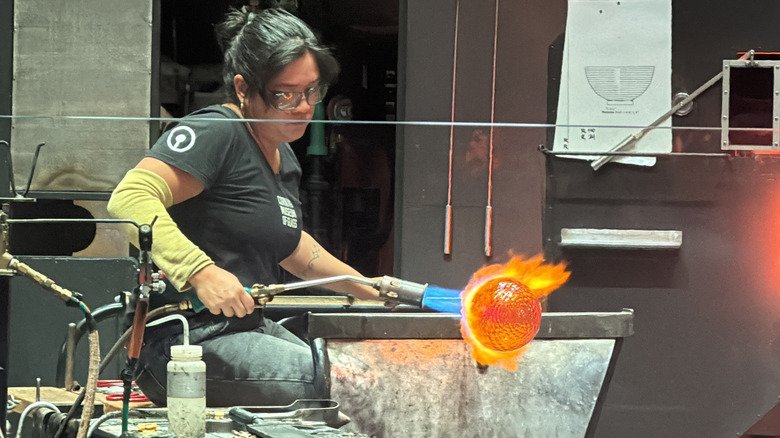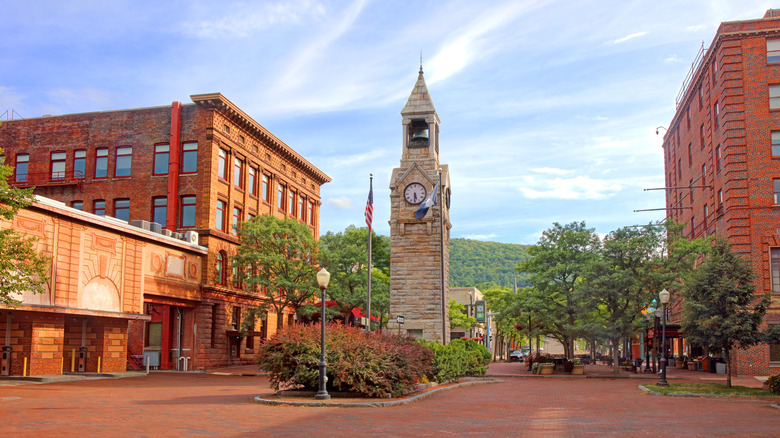A Historic City In New York's Finger Lakes Region Has A Charming Downtown & Cultural Scene
The Finger Lakes region is one of the most beautiful locations in New York state. Filled with charming villages and billed as one of the best wine tasting destinations in the northeast, the Finger Lakes are an ideal spot for visitors who want to experience a side of New York that's away from the big city. While many choose to visit the actual Finger Lakes themselves, the southern area of the region offers equally wonderful visits. And if you want to get a real sense of the southern Finger Lakes, you need to visit Corning, a historic city with a charming downtown and cultural scene.
Officially incorporated in 1852, the city of Corning has been populated since the late 1700s. Originally, Corning made its wealth from trading in timber and establishing railroad networks. Then, in the late 19th and early 20th centuries, Corning became famous for its glassworks. This intricate and delicate art remains integral to city's unique cultural character.
While no lakes border Corning, the Chemung River and surrounding green hills provide the city with its classic Finger Lakes vibe. Only two hours away from the nearest major city, Syracuse – reportedly America's snowiest city – Corning is an easy place to find and a town that beckons you to visit and explore its fascinating past and exciting present.
Experience Corning's glassblowing culture
Part of taking in Corning's unique culture is experiencing its glassworks. Corning Incorporated has been the business mainly responsible for the city's reputation. Since the 1800s, the company has been the driver of some of the industry's leading innovations, including glass for lightbulbs, television screens, fiber optics, Pyrex dishes, damage resistance automotive glass, and smartphone screens. While these innovations have helped shape modern American culture, the glassblowing industry in Corning also has an artistic side to it.
This is on full display at the Corning Museum of Glass, which was founded in the 1950s by Corning Incorporated. Today, the museum contains several galleries of artwork from around the world, innovative designs, and live demos by master glass blowers. There are even opportunities for visitors to blow their own glass alongside a professional.
There are numerous other locations in Corning for you to get your glass fix. One place you need to visit in order to marvel at what is possible with the art form is the Erlacher Steuben Glass Shop. Specializing in carved Steuben glass, this shop showcases and sells intricate pieces of glasswork in the heart of downtown Corning. If you're ever looking for a special gift for someone, or just fancy a look at some incredibly detailed glass pieces, this is the place to be.
Shop and eat in the Gaffer District
While Corning wears its glassblowing heritage as a badge of honor, there is more to this charming city than just glass. The Gaffer District is the city's main shopping area on Market Street and its surrounding alleyways. The Gaffer District is lined with authentic, 19th century store fronts that boast over 250 local businesses, including boutiques, museums, restaurants, and more.
One stop all summer and fall visitors need to make is to the Corning Farmer's Market. Occurring Thursdays between June and October, the Farmer's Market brings over 70 vendors to Riverfront Centennial Park to sell everything from flowers and vegetables, to hard cider and honey. Food trucks and live music are also staples of the market.
And you won't be at a loss for places to eat in the Gaffer District. Stop at Market Street Coffee and Tea for a spot of breakfast, Little Boomer's Burrito Bar for lunch, Laurabelle's Cupcakery for a sweet treat, or Nickel's Pit BBQ for a savory dinner. Finish off your day with a trip back to Riverfront Centennial Park and watch the sun go down over the rolling hills and gentle waters of the Chemung River. Corning is an ideal location for a quiet getaway. And while you're in the area, you can also visit this romantic, storybook Finger Lakes village.


